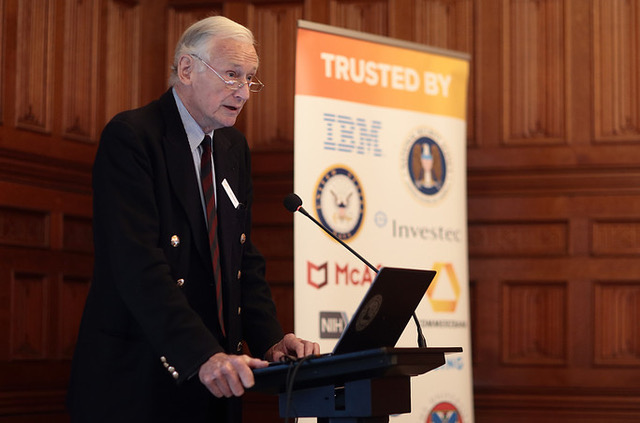“We can’t imagine how much more data we are going to create with data-driven autonomous vehicles, and it is not just cars we are talking about here”, says David Trossell, CEO and CTO of Bridgeworks in this TU Automotive article.
![]()
October 5, 2018
Data volumes are ever increasing and at an unprecedented rate.
Connected and autonomous vehicles will further add to the amount of data that’s currently out there. It’s hard to imagine how much data will be created over the next decade but data will become more vital to our everyday lives – even more so that it is today.
“I don’t think we can even imagine how much more data we are going to create with data-driven automobiles, and it is not just cars we are talking about here”, says David Trossell, CEO and CTO of Bridgeworks before rightly claiming that “it’s about everything that traverses our highways and byways…” He feels that the intelligence gleaned from this data will in time push companies such as Facebook into the background. “However, unlike Facebook, the data is going to be spread across various silos, so accessing or collecting this vast amount of data is going to be a challenge – not only from a transportation point of view, but also from a security perspective.”
He adds that the ability to move voluminous amounts of data over large distances will be problematic, and especially so if it is encrypted. “All the tools that have been traditionally used will no longer work, and so there is going to a need for WAN data acceleration to ensure that the data can be accessed, retrieved, analyzed in real-time, backed up and restored quickly.
This may not seem like an immediate concern of consumers but at a very basic level watching a video online that’s stalled by latency and packet loss can be very frustrating and it’s not something that could have serious consequences for data fueled vehicles, such as connected and autonomous vehicles.
Contributor: connected data
Anupam Malhotra, director of connected vehicles and data at Audi USA, nevertheless comments: “Audi continues to progress on our connected data strategy and we believe this space will be a strong contributor to the future growth of connected services.
A spokesperson for Renovo then gazes into the future: “We will soon live in a world where the touch of a button will summon a driverless highly automated vehicle (HAV) that will take us on safe, convenient urban journeys at extremely low cost. This automated mobility as a service (AMaaS) or robo-taxi paradigm is the most transformative use of HAVs as analyzed by the Rocky Mountain Institute, Boston Consulting Group, McKinsey, RethinkX and others illustrate – all of this leading to trillion-dollar opportunities over the coming decade.”
The spokesperson says Renovo believes that the fastest way for AMaaS to be realized is by a wide-range of companies collaborating together: vehicle manufacturers, automated driving system (ADS) makers, fleet operators, transportation network companies, and many other technology and service providers.” The company calls this “open, interoperable and heterogeneous transportation system the Autonet”, which it claims will involve millions of highly automated, connected, electric and shared vehicles that can be controlled and interacted with securely and in real time.”
Data ownership
Darren Jukes, partner and UK leader of industry for industrial manufacturing and services at PwC reminds us though that the question is about data ownership, which will have an impact of the data fueled vehicle ecosystems ability to collaborate: “Overarching [monetizing connected car data] is the point of: who owns the data? There are many who believe they do, but you must make sure you have the ownership of it. This is a grey area and one where regulation such as [the European Union’s] GDPR is increasing.”
Data monetization
He continues: “The second aspect of being able to monetize is how do you turn data into information? Huge amounts of data is being created every second of every day, and therefore you must be able to turn it into useful data. The data needs to allow the recipient to make more efficient use of the car or of a road or town; or save them money and perhaps to offer them more cost-effective means of transport. The data has to achieve a better outcome, such as a smoother, cheaper or more enjoyable journey in some shape or form.”
He says the location data aspect links in with apps such as Google Maps or Apple Maps, which are used by us for traffic information and to get us from one destination to another. From a mobility services perspective, location allows providers to ensure that the vehicle is close to the user or in proximity to a potential user of a car-sharing scheme.
“From the provider’s perspective, it can show that there is a high propensity of demand in a particular area or street to allow you to move your cars there,” he says before adding: “In smart city scenarios it is about better planning and traffic management to allow traffic to flow more quickly.”
Breaking silos
Putting aside legal and regulatory frameworks for a moment, he stresses that automakers can only break through the data silos by sharing it. For the data fueled vehicle to work for everyone, including the consumer, there must be in his view an “acceptable level of approval to share the data. This requires some knowledge and understanding of what information is needed, and how to improve data quality. To do this there is an imperative to increase data-sharing, but he finds that there several challenges in the way before this can be achieved for the benefits of the supply chain.
He comments: “Across multiple industries we are already seeing the traditional definition of who does what in a supply chain being broken down. The same is true in the automotive sector. Each part of the supply chain is looking at how they can capture more of the value which is leading to silos being broken down.”
Data is required by carmakers and their supply chains to facilitate their ability to “understand better how their service is used, how it relates to other parts of the supply chain and ultimately, how they can develop their propositions to move into new areas,” he explains.
Consumer agreements
In effect the only way this can be achieved is by having some form of transparent agreement with their users, their consumers. This will include an agreement about when location data may be used, how it will be used and why it’s needed. Without such an agreement it’s not possible for the automakers to share user data, and so there also has to some form of communication about what the benefits are for the consumer – such as task automation or a tailored journey. Adding to this challenge is the fact that automakers don’t necessarily have the proprietary data to achieve this result.
The role of AI
However, artificial intelligence (AI) will play an increasing role in delivering data-driven solutions because it enables connected and autonomous vehicles to learn more about their environment, with the aim of allowing them to adapt to it. Jukes explains: “The wider application is for the vehicle to interpret what’s going on to change some properties about its performance. It enables the vehicle to learn about what I prefer to do while I’m driving, why and how I prefer to drive. This can take away some of the decision and AI can improve how I interact with the vehicle more successfully.”
Data fueled prospects
Jukes therefore concludes that future consumers will top up data service just like they top up with gasoline “but whether it’s as frequent as ‘gas’ raises a question mark and if you use the vehicle as a device such as a smartphone, then there is a propensity for people to update and to refresh”.
This may include allowing consumers to download apps and features while providing the latest upgrades, and as this often already happens with smartphones, there should be no difference when it comes to connected and autonomous vehicle. Furthermore, with autonomous vehicles an individual consumer won’t be the driver, and so their desire for more information, media and entertainment services will be exacerbated – even more so that it would be a connected car. So, given this scenario, there will inevitably be a need to top up with data because demand for it will inevitably increase.
Click here to read the complete story at TU Automotive.




